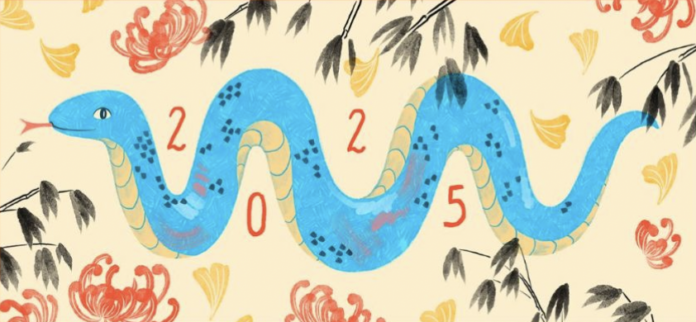*Credit: Natelle Quek
An auspicious animal will be slithering in through your doors on January 29th during the new moon. The Year of the Snake will be upon us soon. You’ll know this if you’ve been closely following the promotions on social media regarding the lunar new year.
For example, the Royal Mint has designed a set of collectible coins for the Year of the Snake. They will cost you a fortune, but over a billion people in China and around the world who consider themselves part of the Chinese diaspora will have no issues with fortune. Aspiring to be fortunate forms part of the lunar new year celebrations, along with good health and happiness.
I’ve been celebrating the lunar new year since I was a babe. I am one of the millions of people who are part of the Chinese diaspora. When I go to schools to give talks about the festival, this is what I tell the children:
Eva Wong Nava was born on a tropical island where a merlion protects its inhabitants from marauding pirates. Her ancestors braved monsoon winds sailing from the Middle Kingdom across the Southern Seas to plant roots in British Malaya. They brought ancient traditions and rituals with them and have practised them in Southeast Asia since the 13th century. When the winds changed, her relatives sailed north, braving hailstorms and snowfall, taking familiar traditions and rituals to America, Europe and England, where they formed new homes and families, and continued practising these traditions in the Western Hemisphere. Eva writes stories for children inspired by her childhood and heritage. She lives in London with a goat, dog and tiger.
There are books galore helping children and their parents, caregivers and teachers celebrate the lunar new year, which is called Chinese New Year by the Chinese and its diaspora, Tet by the Vietnamese and its diaspora, Seollal by the Koreans and their diaspora, and Tsagaan Sar by the Mongolian and its diaspora. While some books are IP (Intellectual Propery) created in-house by publishers, there are also ones written by own voices authors with lived experience of celebrating the lunar new year. I will focus on the ones published in the UK.
For children aged 6 – 9, Eric Huang’s debut duology, Guardians Of the New Moon (Little Tiger), is a fun and pacy read, introducing children to the myth behind the legend of the Great Race and various gods and goddesses of the Chinese pantheon.
*Author’s Instagram
Maisie Chan’s Tiger Warrior series (Hachette) makes for a great close companion. These are good for children 8 plus.
*Author’s Instagram
East Asian Folktales, Myths and Legends (Scholastic) is a collection of stories good for children from nine plus. I had fun researching and retelling the many familiar stories of my childhood. I grew up in a family of storytellers and like the many children of the Chinese diaspora, stories like the Great Race, were passed down orally from one generation to the next.
Also from the same publisher, there is I Love Chinese New Year. This is picture book, with illustrations by Xin Li, a China-born, Norway-based illustrator, is a celebration of the festival for readers from three plus. It gives teachers, who are keen to teach their classes about the festival, tips on how to do this within the story, explanations about the symbolisms in the back matter, and fun facts on why the dragon is still the most revered and favourite animal in the Chinese zodiac. [Hint: the dragon is the only celestial animal in the Chinese zodiac.]
In the UK, there is a dearth of books that explore the Chinese diaspora experience, culture and heritage for children. While there are many editors focusing on Christmas, Eid and Diwali, there are others who understand that often times, books on the lunar new year written by own voices authors are missing.
A new book, Dancing Dumplings For My One And Only (Walker Books), has twirled its way to your kitchen.
This book celebrates family bonds, traditions and a heritage food — the dumpling or jiaozi — and it was released on January 2 in the UK. The publisher had planned it for the 2025 lunar new year market, even though this picture book isn’t strictly about the lunar new year. An author’s note provided by me explains why jiaozi are eaten during this special time of the year.
*the inside cover of Dancing Dumplings For My One And Only
Dancing Dumplings For My One And Only was illustrated by Natelle Quek, a UK-based illustrator of Malaysian-Chinese heritage. I’ll be honest and admit that Walker and I decided to wait for Natelle. Hence what was suppose to be my UK debut became the fifth book in my writing career. by the time it was released.
The Art Director from Walker, Nghiem Ta, said, “After so many years designing children’s books, this is the first project I’ve worked on that fully showcases my heritage.”
This echoes the reality of East and Southeast Asian representation in the UK publishing market. While the Chinese New Year celebrations are gaining traction and becoming more familiar and popular in the United Kingdom, the Vietnamese, Korean and Mongolian lunar new years are barely mentioned and invisible in books and media. But things are changing as the Year of the Snake promises to bring in good omens for those who are patient, stategic and willing to embrace the Snake’s wisdoms. “Slow. Firm. Focused” is the way to go! Like in my favourite Aesop’s tale – slow and steady wins the race.
Wishing one and all a sssmasssshing Year of the Snake!
*
Eva Wong Nava writes for children. She is also a sensitivity editor, ghostwriter and freelance editor. You can find her on Instagram and LinkedIn @evawongnava.











